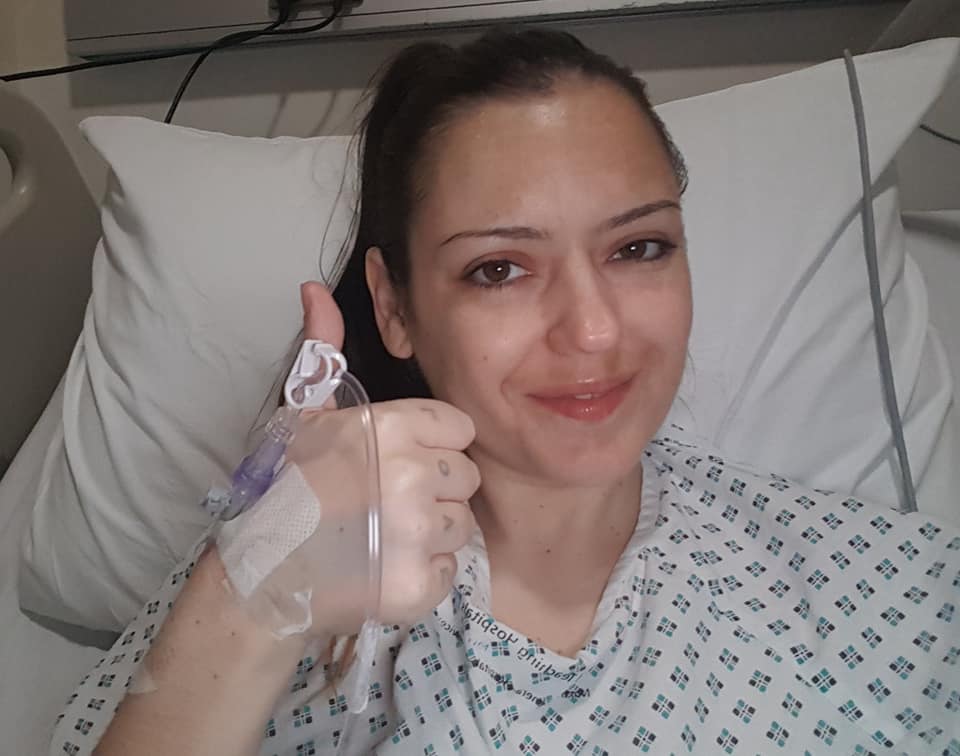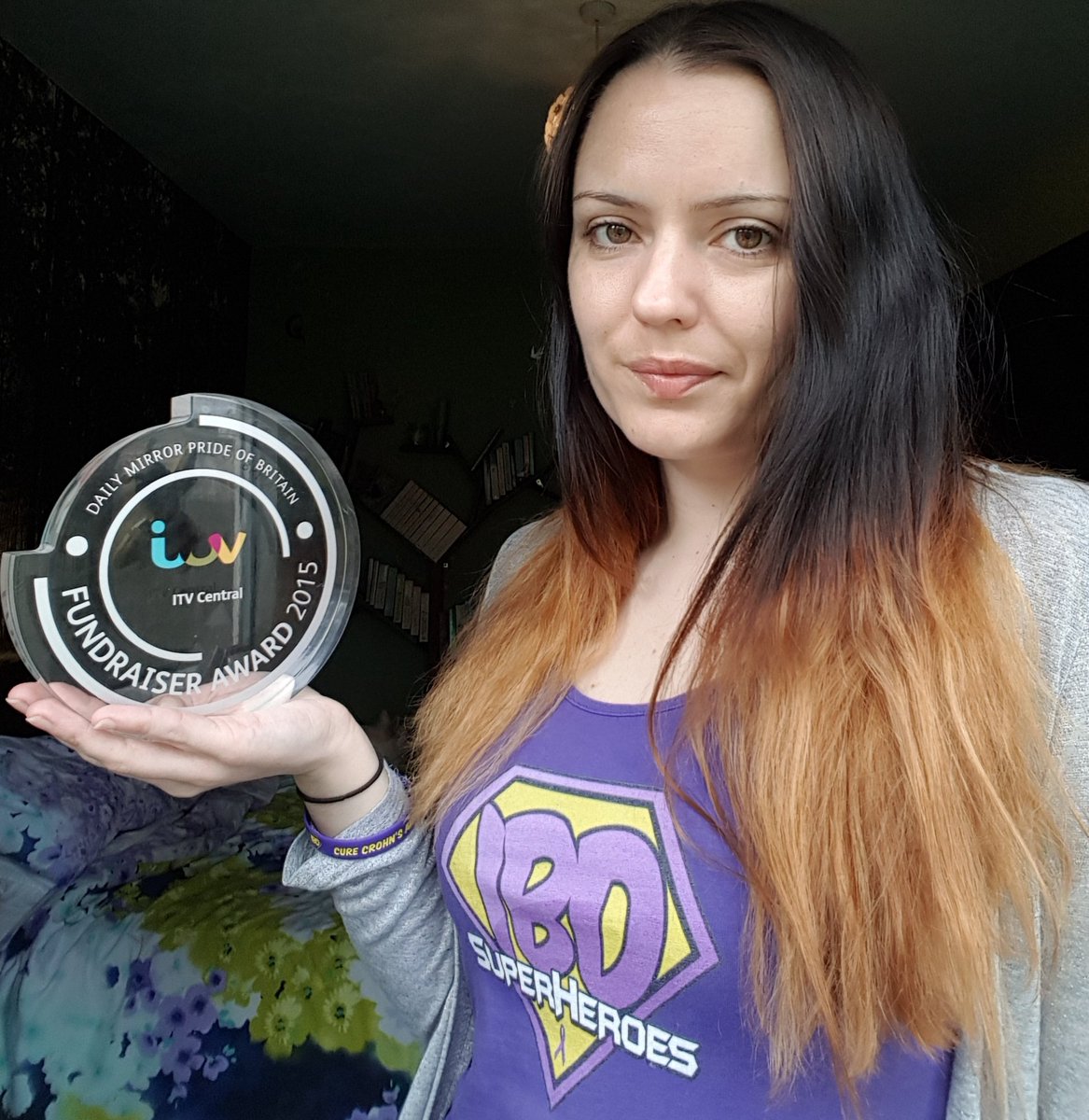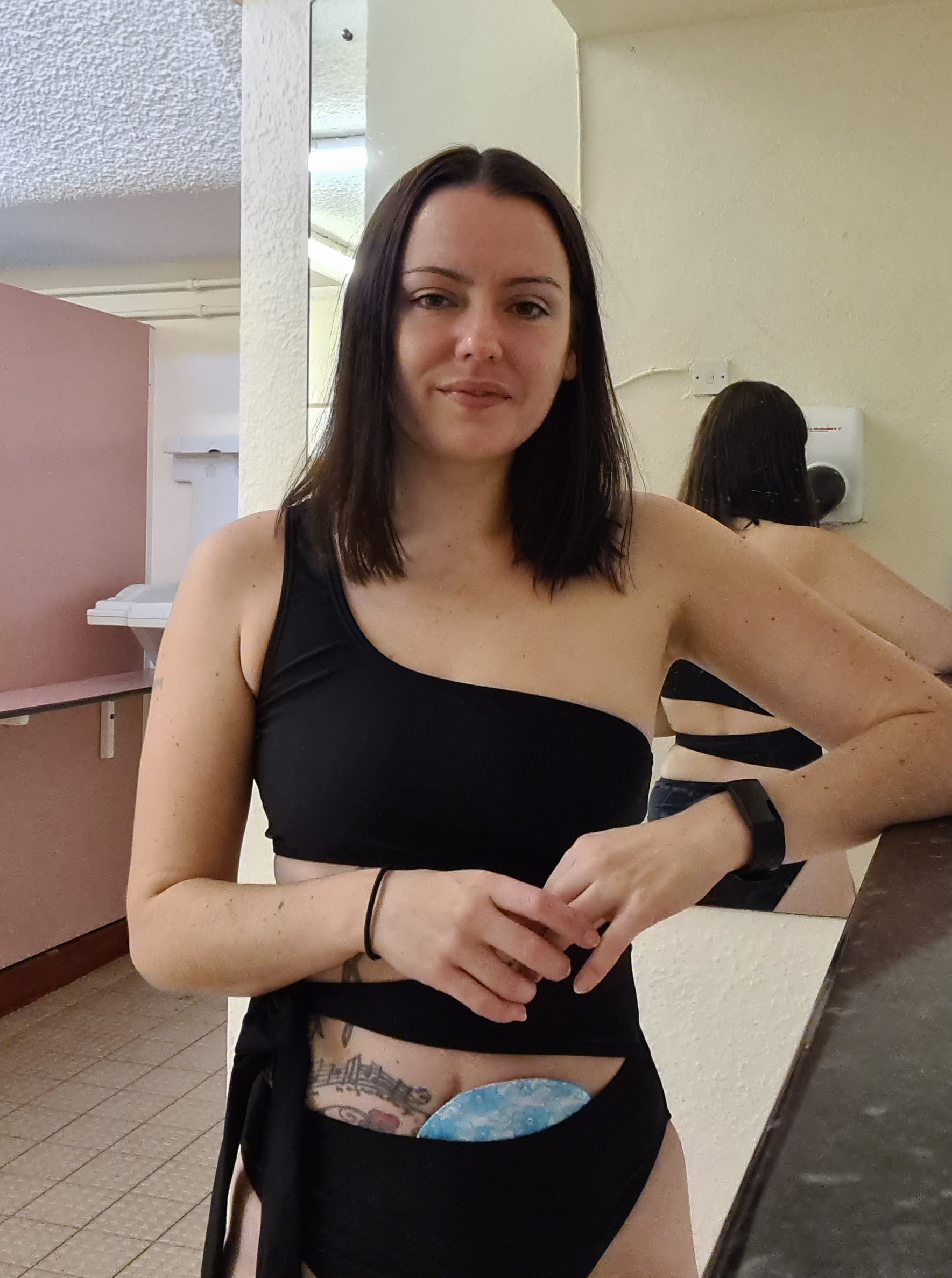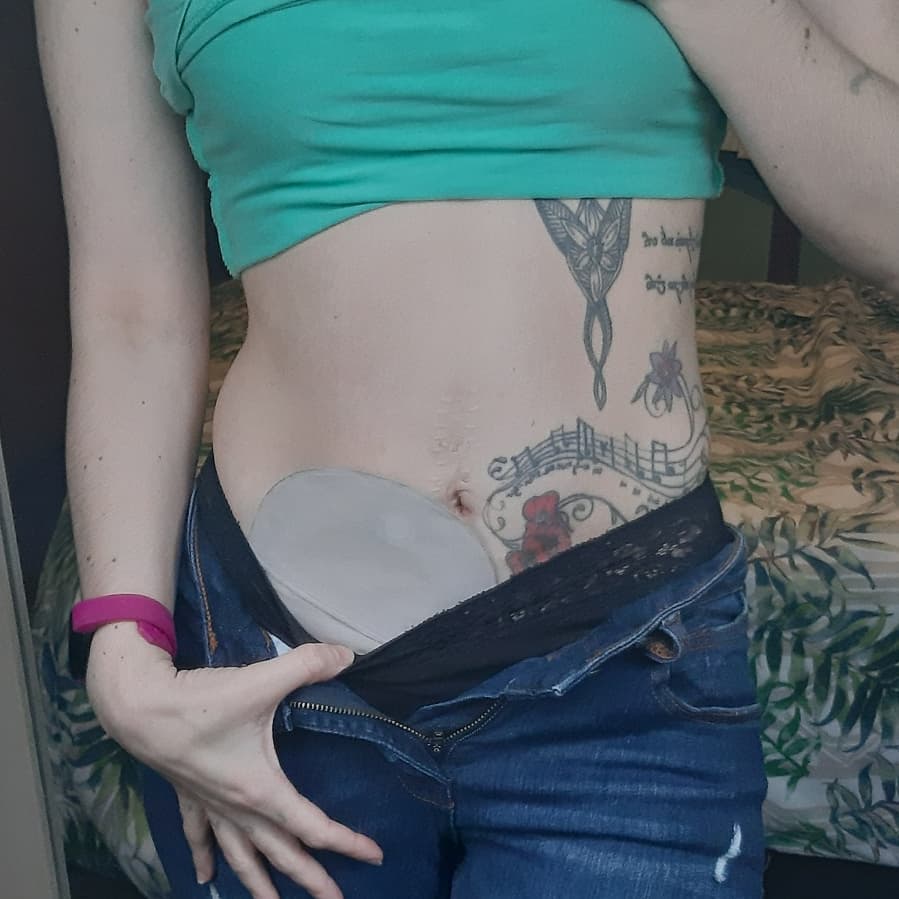In September 2007, I was diagnosed with ulcerative colitis (UC) after just 2 weeks of being very unwell. I went to the hospital’s accident and emergency department, was promptly seen, hooked up to an intravenous drip due to dehydration and whisked away for a colonoscopy. It turned out my entire colon was full of ulcers, so I was immediately admitted for hydrocortisone via IV. A week later, I went under emergency ileostomy surgery to remove my colon. I was someone who was never sick, so being admitted to hospital had been traumatising. Between the surgeries, my stay in hospital consisted of constant tests, nasogastric tubes and drip-feeding. This was not helped by complications, including sepsis and ileus, and ended up needing a physiotherapist to help me walk again. I was only 19, and, up to that point, my life had very much revolved around me having a good time, and the only thing I’d had to worry about was a few spots on my face.
Life as a teenager with a stoma bag
I didn’t have time to process what having UC really meant. I had been given an information booklet when I was admitted to the hospital, but it had led me to believe that, with a few dietary changes and the right medication, all would be well. The next thing I knew, my colon was completely removed, and I was living with an ileostomy and a stoma bag – another thing I’d never heard of before. I would have liked to receive more educational material from the healthcare team, as several other ostomates also feel. I didn’t deal with life with a stoma bag very well. Constant leaks and burnt skin impacted my mental health, and, other than for work, I didn’t really leave the house anymore. My normal clothes had been replaced with jogging bottoms and boys’ t-shirts, in an attempt to cover up the bag.
‘The next thing I knew, my colon was completely removed’
A close up of Sahara's stoma pouch
From a stoma bag to a J-pouch
When I attended my first follow-up appointment with the surgeon, I only had one question. ‘When can I have this reversed?’. Before the surgery to remove my colon, I had been told that removing it would cure my UC, that the stoma was temporary and that it could be removed when my health had improved. The surgeon explained the J-pouch procedure to me. When I was healed, the ileostomy can be reversed, the stoma is removed, and the new pouch is attached internally. My small intestine would be used to create a pouch, which would be attached to my anus and would essentially serve the purpose that my rectum had before it was removed: to store contents of my bowel. He urged me to wait until I had started a family, if that was on my list of things to do, due to the effect that the J-pouch creation would have on my fertility. I went away and thought about it, but because I was having such a hard time and I hated the bag so much, I had the J-pouch built a year after the initial ileostomy surgery. I still hated life with a stoma, but the end was in sight, and that was what I had clung onto to keep myself sane. A year later, in 2009, the J-pouch was connected, and I was finally bag-free again!
Pouchitis
It wasn’t long until my first pouchitis flare. This is an inflammation of the J-pouch’s lining. It wasn’t as bad as my initial UC flare had been, but it was painful, tiring and meant I couldn’t be far from the toilet. Antibiotics (the standard pouchitis treatment) didn’t do anything for me, but steroid medication had helped. I spent the first few years of J-pouch life on and off the steroids, struggling with the side-effects of insomnia, acne, greasy hair, mood swings and a big round face. Eventually though, I reached a point where I couldn’t wean off the steroids without a flare returning, so I had to try new medications. I had a period of remission that lasted 10 months, the longest I’d gone without a flare for years. However, new symptoms emerged during that remission period, causing pain further up in my small intestine. I had a flexi-sigmoidoscopy, an exam used to evaluate the lower part of the large intestine, which identified a stricture, an area of narrowing in the intestines. My consultant advised me to think about having my J-pouch removed, but I wasn’t willing to do that, so I asked for a second opinion. My mindset at the time was that I would rather end my life than go back to life with a bag. The memories of that initial period with a stoma engulfed me, and I was wracked with fear. My consultant referred me to a different hospital, where she thought they may be able to dilate or widen the stricture to reduce the pain and ensure that I could keep the internal J-pouch.
‘I had the J-pouch built a year after the initial ileostomy surgery’
Going online
It was during this time, in 2014, that my frustration had led me to raising awareness online. I was angry that there was so little understanding of my disease, as well as that people assumed I was well because I didn’t ‘look’ sick and managed to go to work every day. Going to work was a case of necessity, to keep a roof over my head, and nothing more. I had a job in social media marketing, which I had started on an apprenticeship, so my knowledge of social media had helped in my awareness-raising mission. I started a blog (www.socialmediaibdostomy.com), which has continuously grown in popularity. This led to me meeting people online who had IBD and stomas, and they were getting on with life, even loving it, because of their bags. What had started as a need to raise awareness had become so much more. It had become a support system, a place of inspiration that I could draw strength from. I loved it, and my mental health improved drastically. I created a Facebook support group and was online at all hours, giving advice, listening, sharing stories, fundraising and raising awareness. I felt like I had found my purpose in life.
The answer is no
The new hospital I was referred to was very quick to see me and also very quick to get me in for tests. A few days after a barium enema x-ray the surgeon called, and I still remember his words to this day. ‘As you know, we were looking into whether we could dilate your strictures, and the answer is no. You have two: one is long and very narrow, and the other is short and very narrow, situated just a few centimetres apart. We need to get you in for surgery urgently. I can book you in for next week.’ My mind couldn’t quite grasp what he was saying. This meant I would need to have another stoma and wear a stoma bag every day. I agreed to the surgery because it didn’t seem like there was another option. In just 5 days, I was going to be having another operation, which wasn’t even on my radar to be thinking about.

Sahara in the hospital
Going back: a J pouch to a stoma
I was marked up on both sides of my stomach for a stoma, just in case. When the doctors began the surgery, they found that my intestine was in fact twisted, and the smaller stricture was an abscess. I woke up with a stoma again. My initial thoughts were rather negative, but remembering the wonderful online stoma community helped me calm myself. My first question to the surgeon was still ‘Is this permanent?’ He told me it wasn’t, and so I breathed a sigh of relief. My overall recovery was smooth, apart from a postoperative ileus, but I had expected that based on all previous surgeries. It was overwhelming to finally be pain-free. I’d been living in a painkiller haze for so long that being free from it felt weird at first. This stoma was so much better than the one I had originally. There were a few leaks, but nothing like what I’d been dealing with before. I stuck with raising awareness and started posting my stoma bag online, and I felt positive about life. I felt so positive in fact, that after just 5 months, when the surgeon called and offered me a reversal surgery date, I was in two minds about whether to or not to go ahead. I decided to give the reversal surgery a go and see what happened. I was confident now that if the time came when I needed a stoma on a permanent basis, which I assumed that I would, I would be okay.
'I would need to have another stoma’
Fundraising and positivity about my permanent stoma
I continued my fundraising and awareness work online, which led to me winning ITV Central’s Fundraiser of the year 2015 Pride of Britain award. I was invited to join the board by the charity I was fundraising for (Cure Crohn’s Colitis) and of course, I joined feeling so proud of how far I’d come. As suspected, pouchitis wasn’t far away. My IBD team tried all the medications that hadn’t worked in the past. I was still experiencing daily pain and discomfort, urgent and frequent toilet trips, which often included passing blood, and a flexi sigmoidoscopy confirmed my J-pouch was full of ulcers. The decision was made to remove my J-pouch in favour of a permanent stoma. It was my light at the end of the tunnel. It felt weird to have gone from being so against having a stoma so recently to being so keen on the idea.

Sahara winning the ITV Central Fundraiser of the year 2015 Pride of Britain award
Unpause my life
I waited to be referred to the surgeon who performed my last two surgeries and waited for appointments and the surgery date, so I used that time to prepare myself for what was ahead. I signed up to multiple ostomy newsletters, read many online resources and ordered samples of stoma supplies. I genuinely looked forward to what was to come. My life had been on hold, like someone had literally pressed pause, and there were many things I felt I needed to do to improve my life, but I just didn’t have the energy or strength. I wanted a new job and to move house, but it all seemed so far away. The surgery to remove my J-pouch, create a permanent stoma and sew up my anus signified the beginning of being able to get back on track. On 18 October 2018, I had my final surgery. Recovery felt long and slow, but eventually I started gaining weight and strength, and then it was Christmas. I was able to enjoy a Christmas dinner with all the trimmings, and I even went on a night out! Overall, my stoma has been great, and I’ve been impressed by the ostomy supplies available. These products had improved drastically in the 4 years I had between stomas, both aesthetically and in terms of adhesion. I am pleased to report that, this time, I have not thrown all my clothes away either. Full briefs and high-waisted bottoms keep everything in place, and, in all honesty, I am not really fussed if people do see my bag through my clothes on occasion. It is what it is, and it’s part of who I am. Everyone around me knows I’ve got it, and they have noticed drastic improvements in my mood since surgery. Weirdly, it feels more normal for me to have a stoma than to not have one. I fell straight back into my routine with it and haven’t looked back. I have been near death more times than I care to remember, and life has been difficult to keep pushing through during the last 15 years, but I am so glad I did keep pushing.
‘I felt positive about life’

Sahara ready for a swim
Where I am now
I’m in a great place at the moment, and since surgery, my career path has changed a lot. I work freelance in the IBD and ostomy space, blogging and moderating forums, and I work as a patient consultant with multiple healthcare companies. I am still working on awareness raising and support via blogs, including IBD Superheroes and my personal blog. I also enjoying supporting Cure Crohn’s Colitis with their digital marketing and communications. I’ve started yoga, walking and swimming, and I have found a love for gardening since moving house just before COVID-19. Life turned out well in the end, and I expect it will for you too.
'I’m in a great place'
Sahara Fleetwood-Beresford is an IBD and ostomy lifestyle blogger and patient consultant
Instagram and Twitter: @sahara88uk


